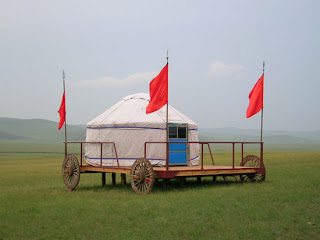
Karl Schuler has done an amazing job with his photography of Mongolia, not to mention the whole world, please take a minute to enjoy some of his great work! http://photo.net/photodb/folder?folder_id=781569
Welcome to the Ontario Yurt Project!! Building my First Yurt in 2010 and my second in 2011 they are now where I call home! This is a blog about living simply through nature!

1. Yurts are the Real Green Deal
TreeHugger reports on Dave Masters (of the Luna Project) and his life in a yurt: "We talk all the time about living with less; Dave lives in 706 square feet with off grid power, a composting toilet, a shower and a full kitchen and didn't give anything up at all to live in comfort and style. When you live in 706 square feet you don't need much to run it; he collects water from his roof, power from the sun and wind, heat from sustainably cut wood. He spends about six hundred bucks a year for his propane barbeque, gas for his chainsaw and log splitter and that is about it."
| Jupiter Images |
2. Yurts are Eco-Friendly
Living in a yurt can help us re-connect to nature, sure, but the literal structure of a traditional yurt is also nature-friendly. The materials are recyclable and should you decide to pick up and move your yurt, there's no residual damage to the ground because no permanent foundation is used.
3. Yurts Have Stood the Test of Time
"They've been used throughout history by nomads in Central Asia," writes Molly Edmonds at HowStuffWorks.com. "Evidence of fourth century B.C. yurts has been discovered, and the oldest complete yurt was found in a 13th century Mongolian grave. The structures were well-suited for the nomadic lifestyle because only a few oxen were required to carry a family's entire home. But the structure was also easy to heat in the cold Mongolian winters where temperatures might reach 50 degrees below Celsius (-58 degrees Fahrenheit)."
| Jupiter Images |
4. Yurts Can Be Modern, Too
By combining the durable yurt concept with a few modern updates, we now have something called a yurta. This form of micro-architecture has optimized the original yurt concept to create a shelter that is steadfast, quick to install, light-weight, easy to transport, minimal in footprint.
5. Yurts are Cheap
The Nomad Yurt, for example, costs a little over $5,000 (US) for a 22-foot diameter version with an insulated skin. If a few comrades pooled together for land, you'd have yourself a yurt commune and giant step forward and away from the unsustainable life.


